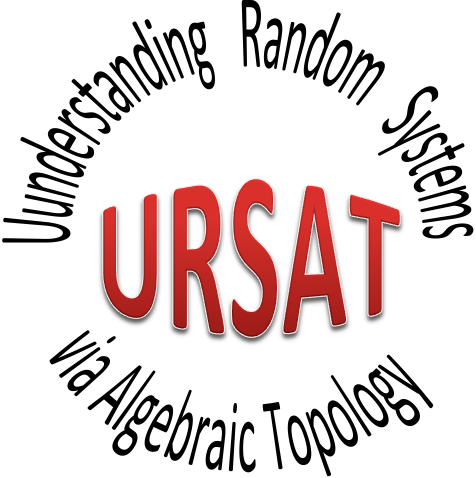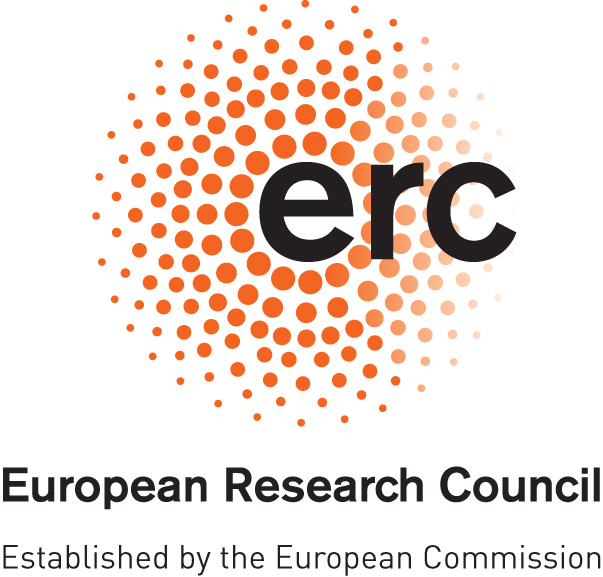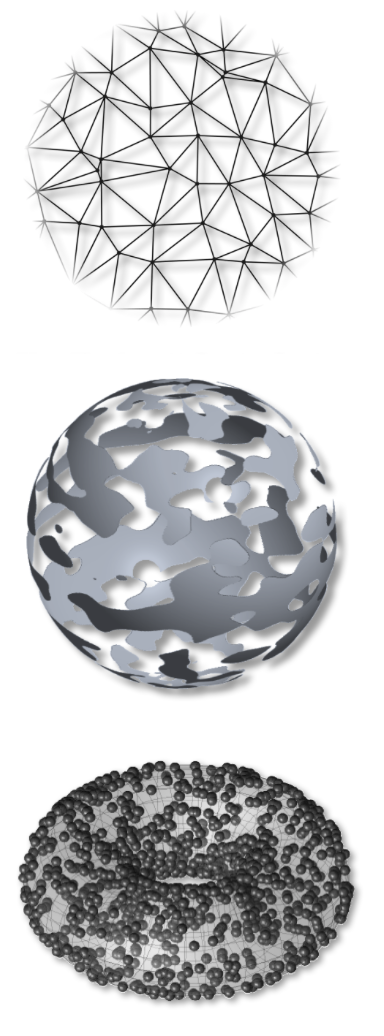URSAT
Understanding Random Systems via Algebraic Topology


This is a project supported by an ERC Advanced grant from 2013-2018 with the acronym URSAT.
It is/was driven by the knowledge that during the first decade of the new millennium there was significant expansion of activity in applying the techniques and theory of algebraic topology to real world problems. To quote my good friend and colleague Shmuel Weinberger, the expression “applied algebraic topology” is no longer an oxymoron!
This expansion generated new mathematical theory, new computational techniques, and even commercial startups. However, around 2009, at a conference on applied topology from the ATMCS series, to which for reasons still unclear to me I had been invited, I realized there wasl an important component of this topological approach that has not been treated in any depth, and this is the inherently stochastic nature of the world.
Since stochastics have always interested me – after all, I am a probabilist – and algebraic topology looked like an interesting thing to learn, I started looking into this. It was immediately clear that there was an urgent need to complement recent developments in applied topology, which had been almost exclusively deterministic, with sophisticated stochastic modeling and analysis. I prepared a proposal – URSAT – to the ERC aiming to attack this issue by applying algebraic topological thinking to random systems, and vice versa. To my great delight, and somewhat to my surprise, the wise men and women in Brussels decided to fund it, to the tune of 1,904,000 Euro.
At the time of writing – which is 4 years into the 5 years of URSAT – the project has exceeded all the expectations that I had for it. (My expectations were actually much lower than the grand aims of the proposal, but who believes their own proposal hyperbole. Nevertheless, even almost all of these grand aims have been reached.)
Over the past 4 years, the two offices next to mine have been a hive of activity, with students and postdocs from areas as far apart as Electrical Engineering, Pure Mathematics (Topology, Knot Theory), Pure and Applied Probability, Statistics, and Cosmology. In addition, a constant flow of short term visitors with an incredible variety of interests and expertise, not to mention frenetic traveling by most of the locals, added tremendous breadth. More often than not, days were spent with visitors just learning one another’s language, before any serious work could be started. It has kept me far busier than I have ever been, and has usually been far more hectic than I would have planned (I am not exactly a youngster any more) but it is/has been an amazing intellectual stimulant.
But, personal aspects aside, this strange mix, and the cross-fertilization it generated, has produced what URSAT was aimed at: Inter- and intra-disciplinary research in a number of problems, driven by applications but with strong topological and probabilistic flavors.
The lists below of long term postdocs and students, short term visitors, and papers, will give you an inkling of what we did/are doing under URSAT.
SEMINAR IN APPLIED AND RANDOM TOPOLOGY
Applied and Random Topology Seminar
The purpose of the ART seminar is to present topics that are related to Mathematical Topology, but in a more applied context (e.g. Probability, Combinatorics, Statistics, Engineering). ART started only in 2016, but is the culmination of 4-5 years of earlier, less formal, seminar series in various aspects of Applied and Random Topology.
POSTDOCTORAL FELLOWS SUPPORTED UNDER URSAT
- Moshe Cohen
- Gugan Thoppe
- Sarit Agami
- Yogeshwaran Dhandapani
- Takashi Owada
- Pratyush Pranav
- Sunder Ram Krishnan (Actually a predoc, but he functions at the level of a postdoc)
URSAT VISITORS
The following list (in no particular order) includes everyone who has (so far) visited the URSAT Technion group under URSAT funds. Most of the visits were for a week or two. Some were for 2-3 months. There are other lists (almost as long) for visitors under SATA (AFOSR funding) and TOPOSYS (a related FP7 project with Primoz Skraba, Mikael Vejdemo-Johansson, Marian Mrojek and Herbert Edelsbrunner). Put them all together, and you will get a feeling for why I waxed poetic above about intellectual stimulation.
Mathias Schulte (Bern)
Anastassia Baxevani (Cyprus)
Takashi Owada (Cornell)
Matthew Wright (IMA, Minnesotta)
Gugan Thoppe (Tata, Mumbai)
Domenico Marinucci (Rome)
Pratyush Pranav (Groningen)
Anthea Monod (Duke)
Sreekar Vadlamani (Tata Institute, Bangalore)
Ed Perkins (UBC)
Omer Bobrowski (Duke)
Yuliy Baryshnikov (U Illinois, Urbana-Champaign)
Raya Feldman (UC, Santa Barbara)
Jonathan Taylor (Stanford)
Shmuel Weinberger (Chicago)
Gennady Samorodnitsky (Cornell)
Yogeshwaran Dhandapani (ISI, Bangalore)
Michel Bertrand (Nantes)
Francesco Vaccarino (Torino)
Herbert Edelsbrunner (IST, Austria)
Primoz Skraba (Jozef Stefan, Ljubljana)
Hubert Wagner (IST, Austria)
Renji Feng (U Peking)
Emanuel Lazar (U Penn)
Bram Petri (Bonn)
Christoph Thale (Bochum)
Armin Schwartzman (UC Davis)
Nicolas Chenavier (Calais)
Valentina Cammarota (King’s College)
Laurent Decreusefond (Paris)
Peter Franek (Czech Academy of Sciences)
URSAT PUBLICATIONS
-
- Krishnan, J.E. Taylor and R.J. Adler The intrinsic geometry of some random manifolds
- G. Naitzat and R.J. Adler, A central limit theorem for the Euler integral of a Gaussian random field
- T. Owada and R.J. Adler, Limit theorems for point processes under geometric constraints (and topological crackle)
- R.J. Adler, S.R. Krishnan, J.E. Taylor and S. Weinberger, Convergence of the reach for a sequence of Gaussian-embedded manifolds
- G. Thoppe, D. Yogeshwaran and R.J. Adler, On the evolution of topology in dynamic Erdos-Renyi graphs
- R.J. Adler and G. Samorodnitsky, Climbing down Gaussian peaks
- D. Yogeshwaran, E. Subag and R.J. Adler, Random geometric complexes in the thermodynamic regime
- D. Yogeshwaran and R.J. Adler, On the topology of random processes built over stationary random processes
- O. Bobrowski and R.J. Adler, Distance functions, critical points, and topology for some random complexes.
- M. Cohen and S. R. Krishnan, Random knots using Chebyshev billiard table diagrams.
- M. Cohen, C. Even-Zohar, and S. R. Krishnan, Crossing numbers of random two-bridge knots.
- T. Owada, Limit theorems for the sum of persistence barcodes of extremes.
- T. Owada, Functional central limit theorem for subgraph counting processes.
- P. Pranav, H. Edelsbrunner, R. van de Weygaert, G. Vegter, M. Kerber, B. Jones, and M. Wintraecken, The Topology of the Cosmic Web in Terms of Persistent Betti Numbers.
- Skraba, G. Thoppe, and D. Yogeshwaran, Randomly weighted d-complexes: Minimal spanning acylces and persistence diagrams.
- R. Feng and R.J. Adler, Critical radius and supremum of random spherical harmonics
- R.J. Adler and S. Agami, Modelling persistence diagrams with planar point processes, and revealing topology with bagplots.
- R. Feng, X. Xu and R.J. Adler, Critical radius and supremum of random spherical harmonics (II)
- S. Agami and R.J. Adler, Modelling of persistent homology
- R.J. Adler, S. Agami and P. Pranav, Modeling and replicating statistical topology, and evidence for CMB non-homogeneity.
- R.J. Adler, S. Agami and P. Pranav, Supplementary Information Appendix for Modeling and replicating statistical topology, and evidence for CMB non-homogeneity.
- R.J. Adler, K. Bartz, S. Kou, and A. Monod, Estimating thresholding levels for random fields via Euler characteristics.
- G. Thoppe and S. Ram Krishnan, Betti Numbers of Gaussian Excursions in the Sparse Regime.
- P. Pranav, R.J. Adler, T. Buchert, H. Edelsbrunner, B.J.T. Jones, A. Schwartzman, H. Wagner, and R. van de Weygaert, Unexpected Topology of the Temperature Fluctuations in the Cosmic Microwave Background
- P. Pranav, R. van de Weygaert, G. Vegter, B.J.T. Jones, R.J. Adler, J. Feldbrugge, C. Park, T. Buchert and M. Kerber, Topology and Geometry of Gaussian random fields I: on Betti Numbers, Euler characteristic and Minkowski functionals